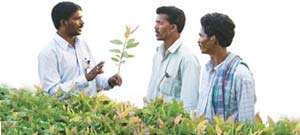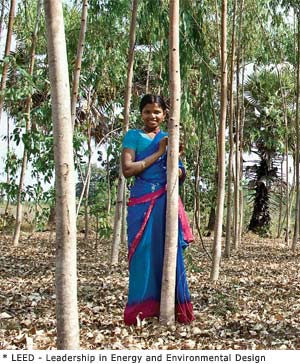 Climate Change Risks Climate Change Risks
Based on our assessment of possible impacts due to climate change on the Company's Businesses, strategies for mitigation and adaptation have been worked out.
Agriculture
| ITC's Triple Bottom Line performance is a holistic approach towards building economic, societal and environmental capital while generating large scale sustainable livelihoods |
Since ITC is largely dependent on agricultural inputs, possible disruption in agricultural patterns and yields is a significant potential risk.
Other than the direct impacts of climate change, water availability is the single largest risk that we forsee.
In addition, reduction in agricultural outputs due to changed weather patterns and higher temperatures not only impacts ITC but also threatens to push millions of farmers beyond the brink, thereby deeply impacting social stability.
ITC’s commitment has been to create a holistic Triple Bottom Line approach that focuses on creating sustainable livelihoods.
 Our water conservation, watershed development and rainwater harvesting projects, not only improve the sustainability of our agri-related businesses, but also create sustainable livelihoods for a large number of marginal farmers. Our R&D specialists, in collaboration with expert study groups are constantly evaluating agricultural productivity/ adaptation issues related to climate change and support is being provided to farmers through in-house extension services. Our water conservation, watershed development and rainwater harvesting projects, not only improve the sustainability of our agri-related businesses, but also create sustainable livelihoods for a large number of marginal farmers. Our R&D specialists, in collaboration with expert study groups are constantly evaluating agricultural productivity/ adaptation issues related to climate change and support is being provided to farmers through in-house extension services.
Built environment
We are also exposed to physical risks related to climate change. We have 2 large manufacturing facilities in coastal areas. Protection of our assets in these coastal areas has been reinforced in anticipation of increased severity of storms and cyclones, which are likely to occur.
 All new buildings have been constructed with the requisite factors of safety. For existing buildings and infrastructure that had to be reinforced, work was taken up in a phased manner and has been completed. All new buildings have been constructed with the requisite factors of safety. For existing buildings and infrastructure that had to be reinforced, work was taken up in a phased manner and has been completed.
Disruption in road and rail traffic by such extreme events may also affect an individual Unit’s output, which has been addressed by appropriate contingency and insurance plans. Higher surface temperatures (increased air conditioning costs) and disruption in water supplies are other anticipated risks.
Green buildings are the obvious response to such challenges. We started the conscious movement towards green buildings by the construction of the ITC Green Centre at Gurgaon, which in 2004 was the largest platinum rated LEED* certified building in the world. All new constructions by ITC now incorporate validated green attributes and efforts are underway to have existing buildings and factories also meet these validated green norms.
In line with this commitment, all ITC premium luxury Hotels are now LEED certified Green buildings with a Platinum rating. |

